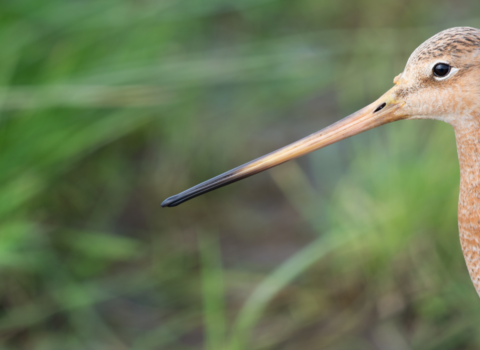Tipner West: Don’t Cross the Line
Legally protected sites for wildlife aren’t yet safe from the threat of development at Tipner West. While the council has temporarily ‘paused’ the super-peninsula, they have also firmly ruled out no development, and is still considering options that include 'reclaiming land' from Portsmouth Harbour's legally protected intertidal and coastal habitats, vital feeding grounds and high-tide roosts for our wading birds.
The Trust and RSPB are challenging the Council to meet their goals for housing and employment without building on protected sites: an immovable red line for nature.
This is our last chance to save nature’s home at Tipner West. We have a short window of opportunity, while the Council sets outs its plans for Tipner West in the Local Plan, to convince the council to support a wilder future for Tipner West that ensures the future of these protected nature sites.
Site designations: Special Protection Area, Site of Special Scientific Interest, Ramsar site
Key species impacted: Brent Geese Dunlin Black-tailed godwit Bass
What are we challenging the council to do at Tipner West?
The RSPB and the Trust recognise that Portsmouth needs new affordable homes, just as nature needs homes, but we can’t let protected sites be destroyed by a lack of ambition. We have therefore set out a challenge to the Council, showing there is a potential solution for Tipner West that meets the Council’s goals for housing and development while safeguarding the sites protected for nature. We have done this to make it harder for the Council to settle on an option that bulldozes over parts of the protected area for nature, which would set a dangerous national precedent and wreak havoc for our local wildlife.
Working with Influence Landscape Architects, we have drawn up images to demonstrate to Portsmouth City Council that it is possible to build a new community with the principles of nature-positive development at its heart, and crucially within the environmental limits of the protected sites at Tipner West.
Our key principles set out the clear red lines for nature - ones that cannot be crossed or risk undermining the legal protections for nature:
-
Take the ‘Lennox Point’ super-peninsula off the table for good.
-
Avoid any direct damage to protected areas for nature. Do not build over any part of Portsmouth Harbour’s Special Protection Area, Site of Special Scientific Interest and Ramsar site, including the intertidal mudflats and coastal meadow for the purpose of extending the 'developable' footprint of the site.
-
Mitigate indirect impacts to the protected areas. Replace supporting habitat, including the Firing Range, for brent geese and wading birds in line with the Solent Wader and Brent Goose Strategy.
-
Create space for wildlife within the Tipner West development. Follow the principles of nature-positive design to create a community that people and wildlife can thrive in.
Timeline
-
March 2018
We responded to Portsmouth City Council’s Tipner Strategic Development Area Consultation expressing our strongest objection to the reclamation of part of Portsmouth Harbour SSSI, SPA and Ramsar site.
-
November 2020
We launched our public campaign and petition to tell Portsmouth City Council #dontgothere
-
March 2021
Over 20,000 people signed our petition telling Portsmouth City Council #DontGoThere
- May 2021
Portsmouth Labour party councillors include scrapping the super-peninsula as a key manifesto point for the local elections.
-
September - October 2021
9,000 people used our joint e-action with the RSPB to respond to Portsmouth City Council's local plan consultation which includes the destructive super-peninsula proposals.
- October 2021
Councillors voted to 'pause and rethink' the super-peninsula plans.
- December 2021
The super-peninsula team will be presenting a report to councillors who will decide the next steps for the project.
- April 2022
Trust and RSPB launch a challenge to Portsmouth City Council to Don't Cross the Line into the protected sites for nature.
- September 2022
Tipner West is 'un-paused'. A cross-party working group supports Trust and the RSPB's principles for Tipner West. But Portsmouth City Council Cabinet put forward two remaining options for Tipner West, either proposals for 1,250 homes, potentially in line with the Trust and RSPBs principles, or damaging new proposals that would reclaim 14ha (over half of the super-peninsula reclamation) for 2,000 homes.
- Winter 2022/2023
The Trust is working closely with councillors and council officers to influence the new proposals that come forward from the council for Tipner West.
- Summer 2023
The council will set out their preferred option and concept masterplan for Tipner West in the Summer 2023, followed by a Local Plan consultation in the Autumn - we will be watching closely to ensure any new plans do not cross red lines for nature - or we'll continue to campaign.
FAQs
Why have the Trust and the RSPB developed concept images for Tipner West?
At the end of 2021, Portsmouth City Council voted to pause the super-peninsula – this was a massive campaign win for us, but the fight isn’t over yet. The Council have firmly ruled out no development as they say they need to provide affordable houses and employment on the site for the City’s residents, in line with the commitments of the City Deal funding they have received from the Government (which included a commitment of 1,250 homes and 35,000 sqm of employment space at Tipner West). And, the options they are now considering for Tipner West would still build over 3.5ha of protected coastal meadow on the southern tip of Tipner West: this is an unacceptable red line for nature that we cannot allow to be crossed.
We have therefore set out a challenge to Portsmouth City Council that if they are going to build on land at Tipner West, they cannot cross the line of destroying designated sites for nature (Special Protection Area, Site of Special Scientific Interest and Ramsar site) and must instead adopt the highest environmental principles for this development. If the Council cannot meet these fundamental principles, then they should not build here at all.
Why are you promoting any building at Tipner West? Why aren’t you asking for the site to be left for wildlife?
All three main parties in Portsmouth, Labour, Conservative and Liberal Democrat, have made it clear that they will not support a ‘do nothing’ option at Tipner West. The RSPB and the Trust want to work with the local community and Council to get the best possible outcome for nature given the political circumstances.
We have therefore set out a challenge to the Council, showing there is a potential alternative vision for Tipner West that meets the Council’s goals for housing and development while safeguarding the protected sites for nature. We have done this to make it harder for the Council to settle on an option that bulldozes over parts of the protected area for nature, which would set a dangerous national precedent and wreak havoc for our local wildlife.
In an ideal world, the unprotected land at Tipner West would be left and enhanced for nature as well. However, with no legal protection this is extremely hard to defend. The RSPB and the Trust also recognise that Portsmouth needs new affordable homes, just as nature needs homes, but we can’t let protected sites be destroyed by a lack of ambition and imagination. That is why we have decided on the unusual move of showing the Council that it is possible to do better for people and nature and setting out clear principles by which Portsmouth City Council must abide if they wish to develop anything at Tipner West.
Why are you not recommending protecting the Tipner Firing Range?
The Tipner Firing Range has no legal site protection for wildlife (Special Protection Area, Site of Special Scientific Interest and Ramsar site), although it does play a key role in supporting wintering brent geese. Because of this supporting role, it is classed as a Primary Support Site in the Solent Wader and Brent Goose Strategy (SWBGS). There is a well-established precedent in place for how development in these circumstances is treated, and this is set out within the SWBGS. If the Council builds over the firing range for housing, they must meet the guidance within the SWBGS Mitigation Guidance, which states:
‘The Primary Support Areas are land that, when in suitable management, make an important contribution to the function of the Solent waders and brent goose ecological network. However, it is generally considered that, where on-site avoidance or mitigation measures are unable to manage impacts, there may be opportunities for the loss or damage to these areas to be off-set by the provision of new sites to ensure a long-term protection and enhancement of the wider wader and brent goose ecological network.’
Therefore, if loss or damage to the site is unavoidable, the Council must identify another site to replace the loss of the Tipner Firing Range Primary Support Area, ensuring that there are significant net benefits to the wader and brent goose ecological network.
Why can't they just build houses elsewhere?
This isn't a question that we can answer, however with the Council firmly ruling out the option for no development at Tipner West we want to make sure the designated sites for nature are protected. Our challenge to the Council shows how the protection of the Special Protection Area, Site of Special Scientific Interest and Ramsar site could be achieved with a nature-positive approach to development.
The Council must assess land availability and find appropriate ways of meeting the required housing levels. We know that Portsmouth is highly constrained by its geography, but these environmental constraints should not be a reason to override legal protections to build on the Special Protection Area, Site of Special Scientific Interest or Ramsar site. There is still the option for the council to make a case for exceptional circumstances to central government and calculate a new method for the housing need for the city that takes these constraints into account.
Will the alternative development options impact the Special Protection Area/Site of Special Scientific Interest?
Current plans being considered for Tipner West by the Council would still build over and destroy 3.5ha of coastal meadow protected as part of the Portsmouth Harbour Special Protection Area (SPA) and Site of Special Scientific Interest (SSSI). As our challenge and concept shows, this could be avoided - but the Council must still take great care to ensure that the protected sites for wildlife are not indirectly damaged.
Given that even the smaller development options now being considered would require building right up to the edge of the SPA and SSSI, it is vital that careful design from the outset ensures that any indirect impacts on these designated sites are avoided. We are especially concerned that more people living in the area will increase disturbance to the bird species using the Special Protection Area, Site of Special Scientific Interest and Ramsar Site. This why we are clear that any development must provide high quality access to nature without increasing recreational disturbance. For example, we have shown in our challenge how a green route around the edge of the development could be raised above the coastal meadow and the shoreline to minimise disturbance to the birds and other wildlife below, while still providing a space for people to connect with nature.
How is your concept better than the super-peninsula?
The Trust and RSPB’s challenge shows that it is possible to work within Tipner West’s environmental limits and place nature at the heart of the design. By adopting such a nature-positive approach to development, it would mean that the Council could build the 1,250 homes and 35,000sqm of employment space (which they are committing to deliver) without breaching the fundamental red line for nature: building over parts of the protected Special Protection Area, Site of Special Scientific Interest and Ramsar site coastal meadow and mudflats.
The super-peninsula would have destroyed at least 27.5ha of protected mudflats and 3.5ha of protected coastal meadow. Other options the Council is still considering, would still destroy 3.5ha of protected coastal meadow. Both of these options are unacceptable and would result in a dangerous precedent for breaking the legal safeguards on protected sites to build houses.
Working with landscape architects, Influence, we have shown how the Council can meet their goals for housing and employment without destroying these sites by building within environmental limits and adopting a nature-positive vision.
Why would building over the Special Protection Area set a precedent?
The mudflats and coastal meadow are legally protected as a Special Protection Area (SPA), Site of Special Scientific Interest (SSSI and Ramsar site in recognition of their importance for wildlife.
Protected sites like these cannot be damaged or destroyed unless there are truly exceptional circumstances. In the case of the SPA and Ramsar site (the highest tier of protection in this country), whoever is promoting the damaging scheme (in this case the Council) must be able to demonstrate that there are no feasible alternative solutions that would be less damaging to the protected sites, and that there are “imperative reasons of overriding public interest” (IROPI) for the proposal to go ahead. The Government would have the final say on that, and if they felt a satisfactory case had been made, then the Council would still have to put in place compensatory measures (in this case replacement mudflat and coastal meadow, significantly greater than the area damaged).
It is clear that these are very strict tests, and as such a successful case has never been made in England to allow housing to be built directly on such a heavily protected site for nature. Therefore, this development could set an extremely dangerous precedent for building many more houses over protected sites nationally. If an area with the highest level of protection for wildlife can be destroyed and built upon for this type of development, nowhere will be safe for nature anymore.
What is protected for wildlife at Tipner West and what isn’t?
Tipner West is a peninsula in the north west of Portsea Island, totaling around 25ha in size. Roughly 10ha at the north of the Tipner West peninsula is currently developed land, used by the cruising, boating and angling club, shipping yard, waste and recycling centre and Harbour School. A further 10ha in the centre of the peninsula is the decommissioned Tipner Firing Range, an important habitat that helps to support the wintering brent geese, but is not part of the legally protected area.
In the southern corner of Tipner West, below the firing range, 3.5ha of coastal meadow is protected as part of the Portsmouth Harbour Site of Special Scientific Interest (SSSI), Special Protection Area (SPA) and Ramsar Site due to its importance as a high tide roost for wintering waders such as brent geese, curlew and dunlin.
Surrounding the whole peninsula, the mudflats around Tipner West are also protected as part of Portsmouth Harbour, Site of Special Scientific Interest (SSSI), Special Protection Area (SPA) and Ramsar site. Together the protected Solent sites support 30% of the UK population of dark-bellied brent geese who migrate every winter from Siberia to feed on our mudflats.
What is a Local Plan and why does it matter for Tipner West?
Local Plans are where the big decisions on planning for the future of communities and land are made. This includes deciding the future of cities, towns and villages, where new development should be built and which areas should be protected from development or enhanced for nature.
If plans that build over protected nature sites at Tipner West are included in the final adopted Local Plan, it makes it much harder for us to challenge the proposals later on as the principle of development will have been agreed and the Council will be committed to delivering it to reach their overall development needs.
Get in touch
Want to get in touch with us about this campaign? Contact campaigns@hiwwt.org.uk
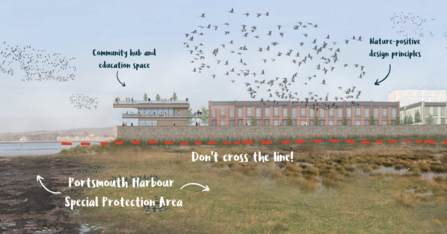
Concept images by Influence Landscape Architects which demonstrate a proposed development which does not cross the line into protected habitats for nature.
Why now?
Last year, 25,000 people signed our joint #DontGoThere petition with the RSPB, and then over 9,000 people joined us to respond to Portsmouth’s Local Plan consultation urging the Council to scrap the super-peninsula.
Our campaigning worked and councillors voted to ‘pause’ the super-peninsula plans! This was a big win for wildlife but the protected sites for nature aren’t safe yet.
Since then, Portsmouth City councillors have ruled out ‘no development’ at Tipner West, as they have firmly committed to delivering 1,250 homes and 35,000sqm of employment space on the site. Now, councillors have just a few months to decide the fate of Tipner West as they choose a proposal to include in the Local Plan.
In September 2022, the councils finally ruled out the super-peninsula for good but put forward two options for Tipner West, including new proposals that would still concrete over 22 football pitches worth of internationally protected habitats, or an option that would just build on the existing landmass.
Any loss of legally protected areas is a fundamental red line for nature. Never before has housing trumped these legal safeguards and should this go ahead, this would open the flood gates for building over protected sites for wildlife across the country.
That is why we need your help one last time to tell the Council: Don’t Cross the Line!
How you can help
Our e-action is now closed. Thank you so much to everyone who took this action and demanded Portsmouth City Councillors Don't Cross the Line at Tipner West. You can still get involved by sharing your support on social media or sending an email to your councillor in Portsmouth asking them to support the Wildlife Trust's principles for Tipner West.
We have provided an example email below that you can adapt. Remember to personalise the email to let your councillor know why this is so important to you:
As a Portsmouth resident in your ward, it is important to me that the legally protected areas for nature at Tipner West remain a home for wildlife.
I welcome the decision to finally scrap the super-peninsula, but as the Council has ruled out the option of no development at this site, I urge that you support the RSPB and Hampshire & Isle of Wight Wildlife Trust’s principles that must be met for any development at Tipner West. I ask you to:
- Take the ‘Lennox Point’ super-peninsula off the table for good.
- Avoid any direct damage to protected areas for nature. Do not build over any part of Portsmouth Harbour’s Special Protection Area, Site of Special Scientific Interest and Ramsar site, including the intertidal mudflats and coastal meadow.
- Mitigate any indirect impacts to the protected areas. Replace supporting habitat, including the Firing Range, for brent geese and wading birds in line with the Solent Wader and Brent Goose Strategy.
- Create space for wildlife within the Tipner West development. Follow the principles of nature-positive design to create a community that people and wildlife can thrive in.
These are fundamental red lines for nature. I want to see our protected sites for nature remain safe, or we risk creating a dangerous ‘Portsmouth Precedent’. As you decide the future of Tipner West through the Local Plan, I urge that you only support development that meets these principles and doesn’t cross that line.
I look forward to hearing from you.
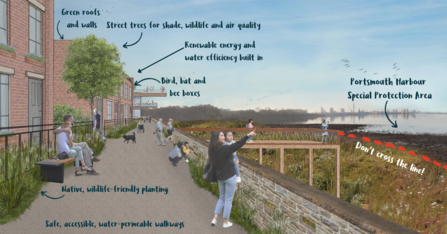
Concept images by Influence Landscape Architects which demonstrate a proposed development which does not cross the line into protected habitats for nature.
Nature-positive design
Tipner West is nestled next to important and legally protected sites on all sides. This makes it an extremely challenging site for development, due to the risks of direct and indirect damage to our protected sites for nature. This is why we urge the council to adopt best practice nature-positive design in the guides below when considering any development at Tipner West.
RSPB and The National House Building Council created this guide which sets out approaches to design and development that work with nature to deliver multiple benefits – for people and wildlife.
The Wildlife Trusts ‘Homes for people and wildlife’ sets out what a good, nature-rich housing development looks like and the benefits it can bring to people and nature.
Can you help?
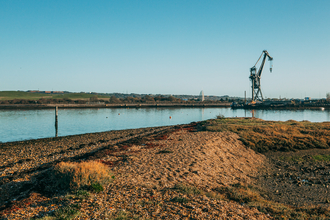
Council ‘fudge’ forces new land reclamation plans at Tipner West
Protected sites once again on the chopping block after Council ignores cross-party attempts to avoid crossing red lines for nature
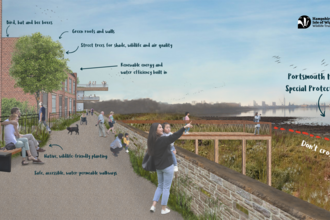
Walking the Line – the challenges of development at Tipner
Portsmouth City Council has ruled out no development at Tipner West but building close to protected sites is immensely challenging. We…
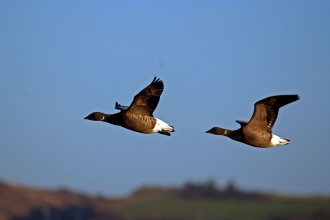
Tipner West – Don't Cross The Line
As Portsmouth Councillors are considering new plans to cross red lines by destroying legally protected nature spaces, the Trust’s Policy…

